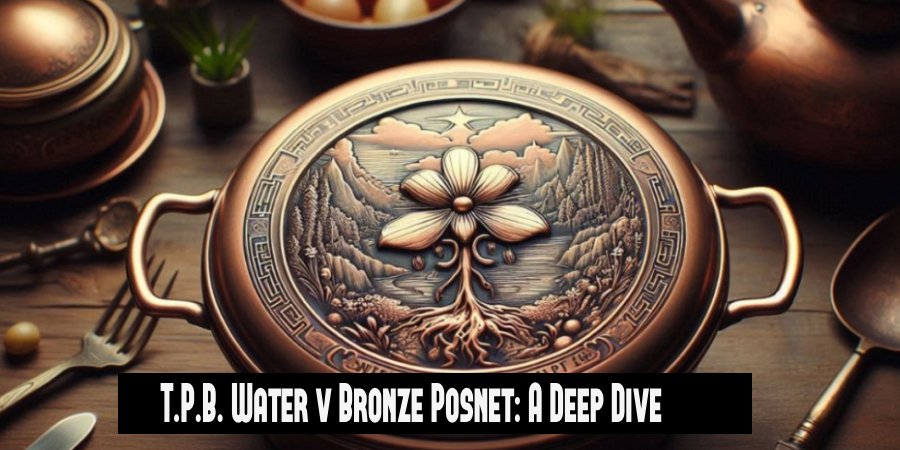Introduction:
In material science, few topics are as intriguing as the debate in T.P.B. Water v Bronze Posnet. It concerns the clash of innovative methods and traditional approaches. This keyword highlights a fascinating contrast. It links old crafts with modern tech. But what does it mean? And why has it caught the attention of enthusiasts and researchers? This article will explore the importance of T.P.B. Water v Bronze Posnet. It will examine its effects in various areas.
What is T.P.B. Water?
The term “T.P.B. Water” stands as a metaphor or reference for a process, material, or philosophy tied to innovation. It often relates to fluid dynamics, green solutions, or new uses of water in engineering, architecture, or art. T.P.B. Water represents an evolution from the mundane to the exceptional. It values adaptability, purity, and versatility.
Water has shown its worth in modern technology. It purifies systems and is a part of sustainable energy. The “T.P.B.” prefix might mean “Technological Purification Benchmark” or “Targeted Purification Base.” It suggests a link to new methods that boost efficiency and sustainability.
What is a Bronze Posnet?
The “Bronze Posnet” roots itself in history and tradition. A posnet is a small, three-legged cooking pot. It’s made of bronze or a similar durable metal. It was used for cooking over an open flame. Bronze, an alloy of copper and tin, symbolizes resilience and longevity. It represents the lasting nature of ancient crafts. The T.P.B. Water v Bronze Posnet is practical. It shows the old-world craft that defined human innovation.
The bronze posnet, though archaic, teaches us about sustainability, efficiency, and simple design. It reminds us of the balance between necessity and resourcefulness. Those traits still resonate in today’s tech-driven world.
The Contrast: Innovation vs. Tradition
T.P.B. Water v Bronze Posnet contrasts in its origins and implications. T.P.B. Water features eco-friendly technology that is at the forefront of innovation. The Bronze Posnet reflects a simpler, more inventive past. This debate raises a recurring question: Should we rely on modern technology alone? Or, can we blend it with lessons from traditional methods to create a balanced future?
Let’s break this down across key areas of impact:
- Sustainability
- T.P.B. Water: Modern systems rank minimal environmental impact. T.P.B. Water leads sustainability efforts. Its advanced filtration, water recycling, and desalination plants are examples.
- Bronze Posnet: While simple, the posnet’s historical use showcases resourcefulness. Bronze is recyclable and durable. It shows a sustainable approach to materials that predates modern awareness.
- Design and Efficiency
- T.P.B. Water: Design in this domain emphasizes optimization. It seeks to cut energy use in water treatment. And, it wants to integrate water systems into urban architecture.
- Bronze Posnet: The posnet’s simple, forged design meets basic needs. It shows the elegance of minimalism. Its efficiency lies in doing much with little, a principle still valuable today.
- Cultural and Historical Value
- T.P.B. Water: It reflects our culture’s drive for innovation, sustainability, and a better life.
- Bronze Posnet: Its history inspires nostalgia and respect for ancient wisdom. It embodies cultural heritage and the evolution of practical tools.
The Fusion of Ideas
Rather than seeing T.P.B. Water v Bronze Posnet as a battle of opposing ideals. It’s more productive to view them as complementary forces. T.P.B. Water’s tech and the Bronze Posnet’s green ideals can create innovative solutions. They must respect modern needs and ancient wisdom.
Case Studies and Applications
- Water Systems with Historical Inspiration: Bronze-like alloys are used in modern water systems. For example, using durable, recyclable materials to build water networks reduces waste. It also ensures they last. It merges traditional craftsmanship with modern needs.
- Sustainable Cooking Solutions: The rise of cast iron and bronze cookware shows a demand for durability. It reflects the sustainability of the Bronze Posnet. Companies now produce cookware that channels these historical traits while incorporating modern ergonomics.
- Eco-Conscious Infrastructure: Municipal projects often use ancient techniques, like the Roman aqueducts. They also use advanced materials and methods inspired by T.P.B. Water. This improves efficiency and reduces ecological footprints.
Challenges in Integration
Integrating T.P.B. Water principles with Bronze Posnet values has potential. But, it is not without challenges. Some of these include:
- Material Compatibility: T.P.B. Water systems use advanced materials. They may not work with the traditional metals of a Bronze Posnet.
- Cost Implications: Merging old and new tech can raise costs, limiting access.
- Cultural Acceptance: We must avoid alienating communities tied to tradition. So, we need to balance innovation with cultural sensitivity.
Why the Debate Matters
The dialogue in T.P.B. Water v Bronze Posnet is not about materials or methods. It reflects humanity’s journey. It asks us to discover methods for responsible innovation. We must not discard the wisdom of our predecessors. By valuing both sides, we can find lasting, meaningful solutions. They will be effective, too.
Final Thoughts
The keyword T.P.B. Water v Bronze Posnet encapsulates a profound exploration of innovation and tradition. It encourages a balanced approach to progress. It can be through sustainable water systems or lessons from old crafts. By applying the principles of both concepts. We can craft a future that honors the past while embracing tomorrow’s potential.
